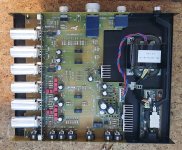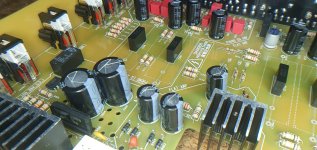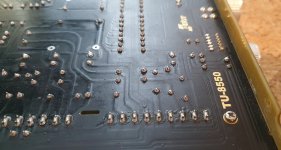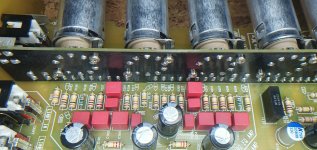@Catcherfly I plan to use the balance hole for this... Not sure if this is possible, but that's the basic idea. I dont think I will ever use the balance function (plan to hard wire it).
Pretty busy with daily work, so not able to spend time realizing this idea. But in general, I believe TU-8550 will be a nice upgrade from my TU-8500. So looking forward to build it.
Pretty busy with daily work, so not able to spend time realizing this idea. But in general, I believe TU-8550 will be a nice upgrade from my TU-8500. So looking forward to build it.
Could this be added to provide remote volume:
https://www.parts-express.com/Line-...oard-with-Remote-6-12-VDC-320-6012?quantity=1
https://www.parts-express.com/Line-...oard-with-Remote-6-12-VDC-320-6012?quantity=1
The Az-cap is manufactured with aluminum foil, which is about 1/10 of the price of copper foil. CuTF is made with PTFE, which is 10x the price of the Jupiter dielectric.Arizona is a oil cap and Jupiter is a copper cap
Vcap CuTF is copper too
CuTF is 2.3times of Jupiter
Jupiter is double the price of Arizona
I bought my TU-8550 a year ago and just recently had the time to put it together. After completing the kit, I'm having an issue with the right channel output. I've got some disconcerting readings: Test point 14 is showing -11.87V (should be 1V), TP16 is showing 196.2 (should be 125-145), TP18 is 160.9 (should be 110-130), and TP20 is 160.8 (should be TP18 + 2). I re-soldered all of those connections just to be safe, and checked the ohms on the un-powered resistors themselves (R224 (12k), R227 (100k), R228 (220k), R229 (47k)) and they all gave a proper reading. Sadly that's about as much as I know to do, does anyone have any suggestions of how to try and resolve this? Thanks in advance.
Last edited:
I can't pinpoint it for you but if the left channel readings are good then something was installed wrong in the right channel. I would compare the two halves of the circuit board part-for-part checking not only the parts but their orientation.
Thanks - I actually wrote Elekit last evening not really expecting a reply and they got back to me already with a suggestion that it could be the heating element on tube V202, possibly caused by a bad solder joint on pins 4 / 5. I'll post again if that solves it.
-- upon closer inspection it looks like the tube itself is bad, there is white oxidation that I could not see before, presumably from a gas leak?
-- upon closer inspection it looks like the tube itself is bad, there is white oxidation that I could not see before, presumably from a gas leak?
Last edited:
The original ALPS 4 channel pot has a linear variation of the resistance and TKD has logarithmic variation of the resistance. The TKD 4 channel pot can't be used in the TU-8550, because VR1 is linear (100k B) and mounted as voltage divider.Just curious, what is the different between TKD and the original pots so it cant be used in the gain stage?
The TKD pot are "stereo volume (real log) control".
The ALPS datasheet mentions B version for tone & general (e.g. voltage divider) and A version for volume.
Managed to find a music store here with some tubes in stock, amp is working perfectly now. What a difference this makes to my 8800! Sounds phenomenal ... I wish I hadn't talked myself out of splurging for the nice capacitors from VK. Time to go for the 8900 maybe... Tube was a dumb oversight on my part, should have been looking more closely (oxidation was barely visible from the top... that's my story and I'm sticking to it), but it's good to know Elekit has such good customer service.
For the release timelines, maybe a TU-9000 this year?Glad to know it worked out. I can second the TU-8900 especially with the 2A3 tubes. It's the best sounding amp I own and I've got five tube amps.
Maybe the KT170 monoblocks?For the release timelines, maybe a TU-9000 this year?
I am not sure if this is still relevant for you, but I have ordered one, and from looking at the schematics, it does not invert phase in either stage.Dear Victor, is this phase inverting preamp? Thank you!
D
Deleted member 544066
No, but I had a TU-8500 briefly connected to an Aleph J and it was nice combination. I think that these pre amps are transparent and they let you listen to the amp.Anybody tried this pre with an F4? Does it have enough juice for the F4?
Hi all.
I've recently completed my build of the TU-8550 pre-amp. Loved building it, and look forward to many hours of listening in the future.
I currently have about 8 hours of run time on the unit. Right from the start, I noticed a constant hum when the phono input was selected. I could also hear the odd pop from time to time on the phono channel only.
With some assistance from Cohiba.Joe (via another forum) I have managed to resolve the popping. I simply moved the unit to the other side of my room, which suggests I had electrical interference from another device.
The hum still remains. I'm hoping someone may have some idea's as to what could be the solution. Here's the path I've taken so far, and the set-up of my unit.
TU-8550 pre-amp
Denon AVR 790 power amp
B&W 685S bookshelf speakers
No hum when music is played from the line 4 (iphone connected to the front input jack).
When the selector is switched to the phono setting, the hum occurs. The hum is unchanged regardless of the turntable being connected to the pre-amp or not. To me, this rules out the turntable as contributing to the cause.
What I've done to try and resolve the issue.
1. Resoldered all the connections.
2. Switched the tubes from the preamp side of the baord to the amp side. If it were a faulty tube, I was expecting the auio from line 4 input to show symptoms in this changed state.
3. I've lined the chassis with copper tape. (sounds strange, but it has worked for others).
The hum is nominally 120Hz (I used an audio tone generator to check). This would suggest a ground loop issue on the phone preamp board. Does that sound fair?
When the unit is operational and the chassis opened, the area region behind the tubes is extremely sensitive to movement. I was investigating if the caps could be the problem, and when moving a timber probing stick behind the tubes (near R108 & R111) the hum was enhanced.
Could it be the tube sockets?
Or one of the installed components?
All the test voltages are within spec.
I'd be interested on to hear some other possible solutions.
Regards
Andrew
I've recently completed my build of the TU-8550 pre-amp. Loved building it, and look forward to many hours of listening in the future.
I currently have about 8 hours of run time on the unit. Right from the start, I noticed a constant hum when the phono input was selected. I could also hear the odd pop from time to time on the phono channel only.
With some assistance from Cohiba.Joe (via another forum) I have managed to resolve the popping. I simply moved the unit to the other side of my room, which suggests I had electrical interference from another device.
The hum still remains. I'm hoping someone may have some idea's as to what could be the solution. Here's the path I've taken so far, and the set-up of my unit.
TU-8550 pre-amp
Denon AVR 790 power amp
B&W 685S bookshelf speakers
No hum when music is played from the line 4 (iphone connected to the front input jack).
When the selector is switched to the phono setting, the hum occurs. The hum is unchanged regardless of the turntable being connected to the pre-amp or not. To me, this rules out the turntable as contributing to the cause.
What I've done to try and resolve the issue.
1. Resoldered all the connections.
2. Switched the tubes from the preamp side of the baord to the amp side. If it were a faulty tube, I was expecting the auio from line 4 input to show symptoms in this changed state.
3. I've lined the chassis with copper tape. (sounds strange, but it has worked for others).
The hum is nominally 120Hz (I used an audio tone generator to check). This would suggest a ground loop issue on the phone preamp board. Does that sound fair?
When the unit is operational and the chassis opened, the area region behind the tubes is extremely sensitive to movement. I was investigating if the caps could be the problem, and when moving a timber probing stick behind the tubes (near R108 & R111) the hum was enhanced.
Could it be the tube sockets?
Or one of the installed components?
All the test voltages are within spec.
I'd be interested on to hear some other possible solutions.
Regards
Andrew
Attachments
Hi Andrew
I want to chat with you to help you to resolve the issue. If you send your phone number to info@vkmusic.com, I can call you. Victor
I want to chat with you to help you to resolve the issue. If you send your phone number to info@vkmusic.com, I can call you. Victor
An update on my build and the small issue I had with humming.
I removed the mosfet and tested it to discover that it was not operating correctly. A replacement was provided, installed and the hum is no longer.
I would highly recommend this build to anyone starting out in the DIY tube amp space. Not only are the instructions easy to follow. The resulting product has a wonderful sound quality but better still, the customer support and care is second to none should anything not go to plan during the build.
The next big question for me is: What Elekit kit do I build next.
Thanks Victor.
🙂
I removed the mosfet and tested it to discover that it was not operating correctly. A replacement was provided, installed and the hum is no longer.
I would highly recommend this build to anyone starting out in the DIY tube amp space. Not only are the instructions easy to follow. The resulting product has a wonderful sound quality but better still, the customer support and care is second to none should anything not go to plan during the build.
The next big question for me is: What Elekit kit do I build next.
Thanks Victor.
🙂




